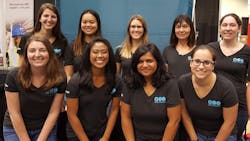Where Are the Women Engineers?
This article is part of TechXchange: Women in Science and Engineering (WISE)
This article appeared in Electronic Design and has been published here with permission.
What you’ll learn:
- Why women commonly leave bachelor studies for the engineering field.
- Why women commonly leave the field of engineering.
- How to be more inclusive of women in professional engineering.
In 2019, women outpaced men in earning bachelor’s degrees in the United States at 57.5%. Women have actually accounted for the majority of bachelor’s degrees since the early 1980s. College rates are also increasing among black Americans, especially women, though racial gaps are still significant. This steady rise is positive to see, but when looking at the more homogenized field of engineering, an industry so core to the tech economy, there’s a disappointing lack of progress.
Only 13% of professional engineers are women.
While business leaders know the inherent strength of diverse teams, prioritizing building those teams has yet to become mainstream in the engineering sector. When teams are predominantly made up of white men, the world’s problems aren’t being examined through other lenses, which means many of the world’s problems aren’t being solved. Diverse teams inspire vital conversations, new questions, and breakthroughs. From a business perspective, this equates to more opportunities for success.
To truly increase representation in engineering requires a comprehensive approach—from ensuring early and equal access to education, to reforming the college curriculum and experience, to building support and leadership trajectories within the industry.
Early Access
There’s an obvious need to prioritize diversity in the engineering industry to truly impact this imbalance, starting in the earliest classrooms. Entire organizations now exist to promote girls’ interest in science, technology, engineering, and mathematics (STEM) fields. However, access to engineering as a field of study greatly remains inequitable, creating an initial obstacle before that inspiration can even happen (Fig. 1).
Unless students are attending specialized or private schools, or grow up in households with caretakers who pursued higher education, there are barriers to entry. Many students don’t even have a baseline exposure to engineering.
Not only should basic engineering be made part of a school curriculum, but demonstrations and hands-on activities also are important to show how science and math can be applicable in imaginative ways. These should be provided by professional engineers from diverse backgrounds to demonstrate that anyone, regardless their gender or race, can become an engineer, too.
College Curriculum
Universities also face a recruitment and retention problem. Women made up 24% of undergraduate engineering students in 2019. But of them, only 3.2% identified as Hispanic and 1.3% as black. Low enrollment rates in higher-education engineering programs among women can be connected to how the subject is taught.
Across electrical engineering, computer-science engineering, and others, lessons are often book-, process- and data-centric. To make these areas of study more approachable for women and people of color, there should be a heavier emphasis on the application of the technology and its clear translation to jobs that they can imagine themselves in at innovative companies they admire.
Once women are in the program, they need allyship and mentorship to stay. Using inclusive examples in teaching, such as referencing famous women and people of color engineers, rather than just white males, creates a stronger sense of belonging. For rising students, the question is no longer “who will be first?” to break through a field, but “will you be next?” When underserved communities feel there’s a place for them, and better yet, opportunities to succeed, they thrive.
As 32% of women transfer out of STEM degree programs in college, it’s shown that community is particularly important in helping women be successful and feel connected, more so than men. Women are in greater need of partnership because they’re already fighting against stigmas, siloes, and imposter syndrome.
Teachers who actively advocate for female students, through nominations for stretch opportunities or personal references for specialized groups or internships, build up students’ confidence to pursue challenges. This positions them for growth and leadership, and these opportunities can be critical to later success. If women feel discouraged or unqualified to even apply, it only further perpetuates the problem of male counterparts advancing at quicker rates.
Entering Engineering
Of the women who graduated and moved into the profession, only 30% report that they stayed in engineering 20 years or more. Given the low representation, it’s no wonder when women are part of critical teams developing world-class products, they’re often plagued with like outsiders, leading to feelings of isolation. Organizations can try to recruit better and create resources for support, but the industry as a whole should ask: Why aren’t more women and women of color choosing to become, and remain, engineers?
When I began my career at global test and measurement company Tektronix in 1999, I was the only woman on my engineering team; there weren’t many people of color working in engineering, either. Now, more than 20 years later, I’m often still the only woman on the teams I lead.
As a woman in engineering, I’ve often felt isolated. Of women who have left the engineering profession, 30% cite organizational climate as the reason. That’s why a sense of community is critical. I started a “Women in Technology” (WIT) group at my company in 2016 to foster an inclusive environment for women. What began as me and a colleague talking over lunch has grown to 300 members that now welcome high-level guest speakers, and it’s become an influential part of the overall Tektronix culture (Fig. 2).
While fostering networking, community, and collaboration, the group has led to an increase in the number of women in engineering and leadership positions at Tektronix. We have a female CEO and a gender-balanced executive team.
Since college, I’ve been hoping to see a change in the number of women working in engineering. What I’ve seen has been slow. While I’m proud of the innovations to which I’ve contributed thus far into my career—such as pioneering new high-end waveform generators—I look forward to continuing to innovate as part of more diverse teams in the future.
That’s because diverse teams succeed. Building more of them in the future depends on a holistic approach, from access to STEM education at a younger age, to advocacy in college programs and purposeful recruitment and retention at the professional level. As engineers, we solve problems. And prioritizing this one will lead to positive real-world impacts.
About the Author
Selu Gupta
Hardware Engineering Manager and Continuous Engineering Support (CES) Strategist, Tektronix
Selu Gupta is a Hardware Engineering Manager and a Continuous Engineering Support (CES) Strategist at Tektronix. She has 22 years of hands-on experience and is responsible for creating the framework and processes that allow engineers at Tektronix to conceive of and build test and measurement equipment. She is the co-founder and lead of Tektronix’s Women in Technology (WIT) organization.


